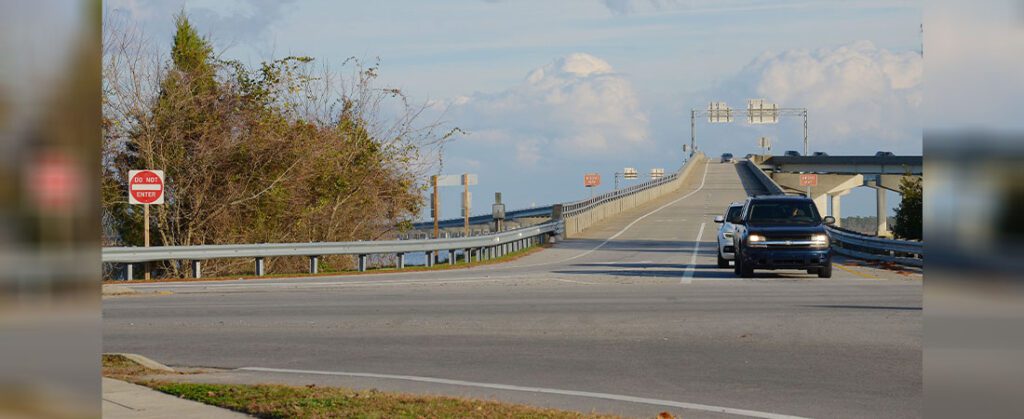
A section of New Bern highway and a waterline damaged during Hurricane Florence will receive a unique form of protection from a $200,000 state grant.
During the December 4 meeting of the Craven County Board of Commissioners, Chad Strawn, director of Planning and Inspections, announced that the county has been awarded a grant from the North Carolina Department of Justice, Environmental Enhancement Grant program. The funds will be used to install 300 feet of marsh sill and what’s known as a “living shoreline” at the US 17/70 bridge abutment on-off ramp, which is located near the Bridgepointe Marina and Outback Steakhouse in downtown New Bern.
The section of road was damaged during Hurricane Florence in 2018 and was closed for approximately six months while new asphalt was laid and other repairs were made.
The goal of the living shoreline project is to protect the bridge abutment from sustaining future damage from storms, Strawn said. It is also designed to protect an 8-inch water line that provides water to much of the James City and Brices Creek area.
Strawn explained that the shoreline beside the bridge abutment is exposed to open water winds from the northeast that come across the river over a distance of two miles. Strawn said during Hurricane Florence waves that impacted the shoreline undercut a large portion of the roadbed and came very close to the waterline at the intersection.
“That’s a lot of energy coming at that location, just 45 to 55 mile per hour winds that can cause some wave damage,” Strawn said.
A living shoreline is a protected, stabilized coastal shoreline that is made of natural materials such as plants, sand, or rock. Unlike a concrete seawall or other hard structure which impedes the growth of plants and animals, living shorelines grow over time.
According to Strawn, a breakwater made of granite will be placed 15 yards offshore near the US 17/70 bridge abutment. When waves come over the breakwater, they will deposit sand and sediment, which will allow plants to establish growth and create a new buffer area to protect the waterline and roadbed.
Strawn said he hoped to have the breakwater in place within the next six months.
“Eventually a bigger beach will grow and cause a protection measure for that whole area,” Strawn said. “I think in two years you’ll start seeing a good amount of accretion of land behind that breakwater. And it depends on the establishment of the wetland species that take effect behind that marsh seal, but I think you’ll see pretty good maturity within five years.”
Commissioners unanimously approved a budget amendment and memorandum of understanding for the project.
In other business, the board also approved a rollover budget amendment for $388,939 in Streamflow Rehabilitation Assistance Program funds. The money will be used to complete an ongoing project to remove stream debris from a 2.96-mile segment of Swift Creek between Butler Ford Road and NC 118.
The work for the project was not finished during the last fiscal year, requiring that the funds be rolled over into our current fiscal year. Strawn said the work is now roughly 80% complete.
StRAP funds are intended to reduce flooding by removing stream debris across the state’s waterways through “proactive efforts” rather than reactive following storm events, Strawn said.
By Todd Wetherington, co-editor. Send an email with questions or comments.

